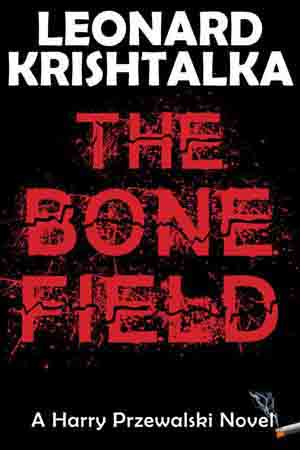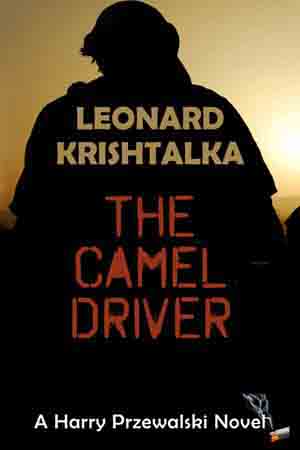NEW HARD-BOILED DETECTIVE SERIES UNCOVERS BONES, BODIES & MURDER!
“Intriguing … astute … satisfyingly twisty.”
~ Publishers Weekly
“A fresh, intellectually lively, hard-boiled murder mystery.”
~ Kirkus Reviews
Paleontologist turned private investigator, Harry Przewalski, excavates the dirty underbelly of people’s lives, unearthing sexual betrayals, treachery, fraud and murder buried beneath the science of petrified shards, skin and bones. Ultimately, he must face a brutal killing in his own past, when he fled to a desert war and came back with a gun and a license to detect.

In his first case, The Bone Field, Przewalski chases a missing paleontologist across 80 million years of intrigue and death, from a Wyoming bone field of petrified skeletons to the bone rooms of the museum.
World-renowned museum paleontologist Peter Marchand vanishes while leading a dinosaur dig in the sweltering, desert badlands of Wyoming. He has made enemies from his serial womanizing, ruthless dealings, religious blasphemy, and unorthodox theories. Hired to find him, Pittsburgh private detective Harry Przewalski uncovers a tangle of sexual deceit, betrayal, and scientific fraud. Ultimately, he must excavate the nightmares in his own extinct past to keep from being killed.
The first installment in the Harry Przewalski series. The second and third are Death Spoke and The Camel Driver.

In his second case, Death Spoke, the murder of an expert on prehistoric cave art immerses Przewalski in a famous painted cavern in France, a World War II atrocity, an archaeological fraud, and a diabolical act of revenge. Przewalski excavates the deadly archaeological layers of the case finding lives torn by deceit, vendetta and redemption.
Gold medal, best novel, Fiction––Mystery/Thriller, Midwest Book Awards
“The best this genre has to offer: a riveting exploration of a crime … a deeply stirring examination of human nature.
A cinematically immersive murder mystery …
an intellectual drama.” — Kirkus Reviews

In his third case, The Camel Driver, Przewalski is hired to uncover the macabre history of Arab Courier. Who is the camel driver—the Bedouin’s skull, skeleton and skin are mounted under his clothing? Who is the child—why was its mummified hand sewn into the camel’s belly. Is the vandalism connected to an apparent suicide of a brilliant museum archaeologist?
“A fiercely intelligent crime drama as emotionally sharp as it is historically inventive. Krishtalka’s prose is powerfully versatile, alternating between the sort of terse, unsentimental phrasing that one would expect from a detective story and poetical elegance.” —Kirkus Reviews
“A fascinating look through the lens of history at murder and mystery. What starts as far back in time as thousands of years ago ends with a contemporary investigation into a mystifying death of a child. Written in a poetic style, this book is destined to become a classic within its genre. Definitely recommended!”
—Cindy McBride, NetGalley Reviewer

Leonard Krishtalka is the author of award-winning essays, the acclaimed book, Dinosaur Plots, The Harry Przewalski Series, and the soon to be released historical murder mystery, The Body on the Bed. As a paleontologist, he has worked throughout the fossil-rich badlands of the American west, Canada, Patagonia, China, Ethiopia, and Kenya. Coming soon: “The Body on the Bed,” an historical murder mystery.
Krishtalka cut his paleontological teeth as a graduate student in the Cretaceous Red Deer River badlands of southern Alberta, where he discovered a beautifully-preserved skull of the horned dinosaur, Centrosaurus, now on display at the museum in the Geology Building at the University of Alberta, Edmonton. After earning his doctorate degree in evolutionary biology, he worked as a research paleontologist at the Carnegie Museum of Natural History, Pittsburgh, where the Harry Przewalski novels began to evolve. Krishtalka’s research encompassed the early evolution 55 million years ago of the many of the modern groups of mammals, such as primitive bats, marsupials, hedgehogs, lemur-like primates, horses, rhinoceroses, and others. He also worked with paleoanthropologists in the Turkana region of Kenya and the Afar region of Ethiopia in the search for fossil hominids–ancient ancestors on the evolutionary tree of Homo sapiens, 4 million to 1 million years old–and their contemporaneous mammal faunas on the African savannas. As part of a University of California expedition to the Afar, he found part of the skull of Australopithecus afarensis, the species of hominid popularly known as “Lucy.”
